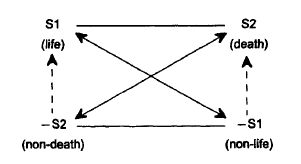
The deep or abstract level
 المؤلف:
Bronwen Martin and Felizitas Ringham
المؤلف:
Bronwen Martin and Felizitas Ringham
 المصدر:
Dictionary of Semiotics
المصدر:
Dictionary of Semiotics
 الجزء والصفحة:
P12
الجزء والصفحة:
P12
 2025-05-06
2025-05-06
 531
531
The deep or abstract level
After analysing the narrative level of meaning, the next stage is to examine the deep level, sometimes also known as the thematic level. This is the level of abstract or conceptual syntax where the fundamental values which generate a text are articulated. These values can be presented in the form of a semiotic square.
The semiotic square is a visual presentation of the elementary structure of meaning. Articulating the relationships of contrariety (opposition), contradiction and implication, it is the logical expression of any semantic category.

(1) SI and S2 are in a relation of opposition or contrariety (one term presupposes the other).
(2) SI and —SI are in a relation of contradiction: —SI negates SI. S2 and — S2 are also in a relation of contradiction: — S2 negates S2.
(3) —SI and S2 are in a relation of implication: —SI implies S2. Similarly, — S2 implies SI.
The semiotic square is a useful tool to illustrate the basic semantic or thematic oppositions underpinning a text. It also makes it possible to show textual dynamics by plotting essential stages or transformations in a story and to follow the narrative trajectory of the subject.
 الاكثر قراءة في Semiotics
الاكثر قراءة في Semiotics
 اخر الاخبار
اخر الاخبار
اخبار العتبة العباسية المقدسة


